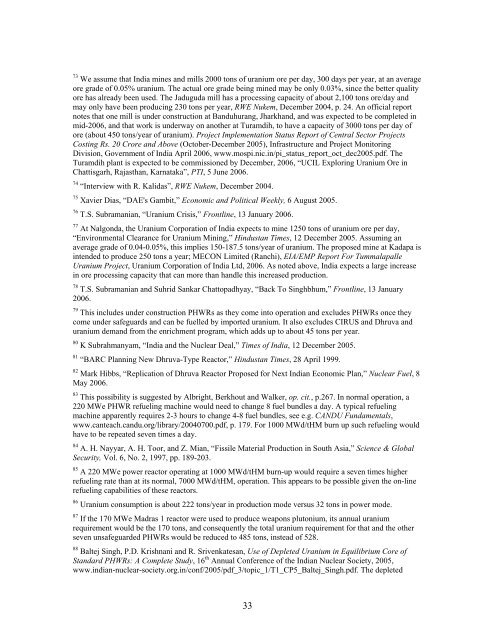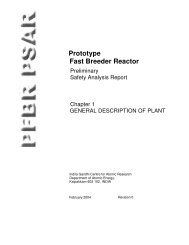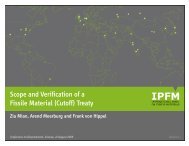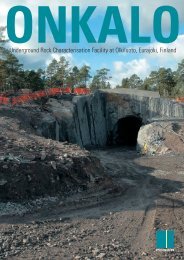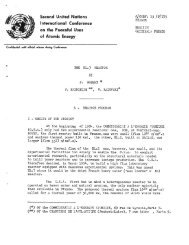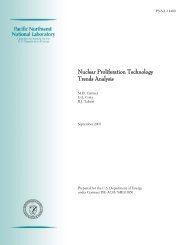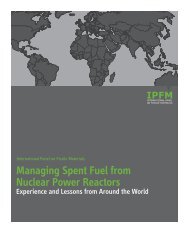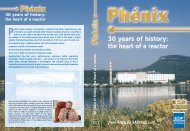Research Report No - International Panel on Fissile Materials
Research Report No - International Panel on Fissile Materials
Research Report No - International Panel on Fissile Materials
You also want an ePaper? Increase the reach of your titles
YUMPU automatically turns print PDFs into web optimized ePapers that Google loves.
73 We assume that India mines and mills 2000 t<strong>on</strong>s of uranium ore per day, 300 days per year, at an average<br />
ore grade of 0.05% uranium. The actual ore grade being mined may be <strong>on</strong>ly 0.03%, since the better quality<br />
ore has already been used. The Jaduguda mill has a processing capacity of about 2,100 t<strong>on</strong>s ore/day and<br />
may <strong>on</strong>ly have been producing 230 t<strong>on</strong>s per year, RWE Nukem, December 2004, p. 24. An official report<br />
notes that <strong>on</strong>e mill is under c<strong>on</strong>structi<strong>on</strong> at Banduhurang, Jharkhand, and was expected to be completed in<br />
mid-2006, and that work is underway <strong>on</strong> another at Turamdih, to have a capacity of 3000 t<strong>on</strong>s per day of<br />
ore (about 450 t<strong>on</strong>s/year of uranium). Project Implementati<strong>on</strong> Status <str<strong>on</strong>g>Report</str<strong>on</strong>g> of Central Sector Projects<br />
Costing Rs. 20 Crore and Above (October-December 2005), Infrastructure and Project M<strong>on</strong>itoring<br />
Divisi<strong>on</strong>, Government of India April 2006, www.mospi.nic.in/pi_status_report_oct_dec2005.pdf. The<br />
Turamdih plant is expected to be commissi<strong>on</strong>ed by December, 2006, “UCIL Exploring Uranium Ore in<br />
Chattisgarh, Rajasthan, Karnataka”, PTI, 5 June 2006.<br />
74 “Interview with R. Kalidas”, RWE Nukem, December 2004.<br />
75 Xavier Dias, “DAE's Gambit,” Ec<strong>on</strong>omic and Political Weekly, 6 August 2005.<br />
76 T.S. Subramanian, “Uranium Crisis,” Fr<strong>on</strong>tline, 13 January 2006.<br />
77 At Nalg<strong>on</strong>da, the Uranium Corporati<strong>on</strong> of India expects to mine 1250 t<strong>on</strong>s of uranium ore per day,<br />
“Envir<strong>on</strong>mental Clearance for Uranium Mining,” Hindustan Times, 12 December 2005. Assuming an<br />
average grade of 0.04-0.05%, this implies 150-187.5 t<strong>on</strong>s/year of uranium. The proposed mine at Kadapa is<br />
intended to produce 250 t<strong>on</strong>s a year; MECON Limited (Ranchi), EIA/EMP <str<strong>on</strong>g>Report</str<strong>on</strong>g> For Tummalapalle<br />
Uranium Project, Uranium Corporati<strong>on</strong> of India Ltd, 2006. As noted above, India expects a large increase<br />
in ore processing capacity that can more than handle this increased producti<strong>on</strong>.<br />
78 T.S. Subramanian and Suhrid Sankar Chattopadhyay, “Back To Singhbhum,” Fr<strong>on</strong>tline, 13 January<br />
2006.<br />
79 This includes under c<strong>on</strong>structi<strong>on</strong> PHWRs as they come into operati<strong>on</strong> and excludes PHWRs <strong>on</strong>ce they<br />
come under safeguards and can be fuelled by imported uranium. It also excludes CIRUS and Dhruva and<br />
uranium demand from the enrichment program, which adds up to about 45 t<strong>on</strong>s per year.<br />
80 K Subrahmanyam, “India and the Nuclear Deal,” Times of India, 12 December 2005.<br />
81 “BARC Planning New Dhruva-Type Reactor,” Hindustan Times, 28 April 1999.<br />
82 Mark Hibbs, “Replicati<strong>on</strong> of Dhruva Reactor Proposed for Next Indian Ec<strong>on</strong>omic Plan,” Nuclear Fuel, 8<br />
May 2006.<br />
83 This possibility is suggested by Albright, Berkhout and Walker, op. cit., p.267. In normal operati<strong>on</strong>, a<br />
220 MWe PHWR refueling machine would need to change 8 fuel bundles a day. A typical refueling<br />
machine apparently requires 2-3 hours to change 4-8 fuel bundles, see e.g. CANDU Fundamentals,<br />
www.canteach.candu.org/library/20040700.pdf, p. 179. For 1000 MWd/tHM burn up such refueling would<br />
have to be repeated seven times a day.<br />
84 A. H. Nayyar, A. H. Toor, and Z. Mian, “<strong>Fissile</strong> Material Producti<strong>on</strong> in South Asia,” Science & Global<br />
Security, Vol. 6, <str<strong>on</strong>g>No</str<strong>on</strong>g>. 2, 1997, pp. 189-203.<br />
85 A 220 MWe power reactor operating at 1000 MWd/tHM burn-up would require a seven times higher<br />
refueling rate than at its normal, 7000 MWd/tHM, operati<strong>on</strong>. This appears to be possible given the <strong>on</strong>-line<br />
refueling capabilities of these reactors.<br />
86 Uranium c<strong>on</strong>sumpti<strong>on</strong> is about 222 t<strong>on</strong>s/year in producti<strong>on</strong> mode versus 32 t<strong>on</strong>s in power mode.<br />
87 If the 170 MWe Madras 1 reactor were used to produce weap<strong>on</strong>s plut<strong>on</strong>ium, its annual uranium<br />
requirement would be the 170 t<strong>on</strong>s, and c<strong>on</strong>sequently the total uranium requirement for that and the other<br />
seven unsafeguarded PHWRs would be reduced to 485 t<strong>on</strong>s, instead of 528.<br />
88 Baltej Singh, P.D. Krishnani and R. Srivenkatesan, Use of Depleted Uranium in Equilibrium Core of<br />
Standard PHWRs: A Complete Study, 16 th Annual C<strong>on</strong>ference of the Indian Nuclear Society, 2005,<br />
www.indian-nuclear-society.org.in/c<strong>on</strong>f/2005/pdf_3/topic_1/T1_CP5_Baltej_Singh.pdf. The depleted<br />
33


